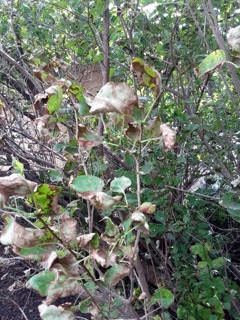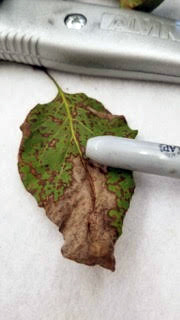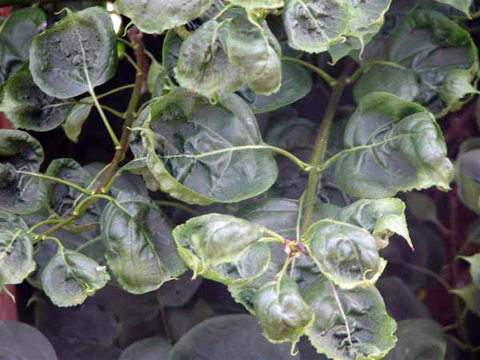Ask Extension: My lilacs seem to be dying. What can I do?
People have been reporting issues with lilacs dying to Extension Master Gardener volunteers this season. Find out what may be causing the problem and what, if anything, can be done to remedy it.
What species of lilacs are affected and how?
Dieback on common lilac due to fungal infection
- Syringa vulgaris, the common lilac, is reportedly the most affected species. S. reticulata the tree lilac, is also susceptible. Whether specific cultivars are affected more than others is unknown mainly because most people don't know the cultivar.
- Affected plants are reportedly mature and have "never been a problem" before this year.
- Symptoms:
- Leaves turn yellow, then brown, and then drop.
- Branch dieback is random, on one shrub in the middle of a hedge, all one side of a hedge, or on individual branches.
How does weather affect the emergence of a pathogen or condition?
According to the UMN Plant Disease Clinic, in May 2020, we had about a week of very cold temperatures without snow cover, possibly compromising root systems.
MN WeatherTalk, a weekly blog by climatologist Mark Seeley, reports that we experienced a stretch of very tropical temperatures in June and July that set records.
- July 2020 was the 14th warmest and 14th wettest since 1895.
- Day temperatures were in the 90s, nights in the 70s and dew points over 70 degrees F. Conditions like these can stress plants in various ways, slow down development, and volatilize herbicides.
- Drought and flooding varied throughout the state as well.
- Storms can also cause damage with saturated soil, standing water and erosion.
- Insects can cause damage and vector diseases.
What are known lilac issues that might produce these symptoms?
Fungal diseases
Pseudocercospora leaf spot
The Plant Disease Clinic has analyzed lilac samples this season and found the fungal disease Lilac Pseudocercospora leaf spot to be present. Symptoms are the same as reported (yellowing then browning leaves, dieback).
The PDC emphasizes sanitation as it seems that the spores of Pseudocercospora can persist for several years on plant debris (leaves, stems, dead flowers, bark).
- Clean up fallen leaves to help reduce the likelihood of reinfection next season.
- Renewal pruning to decrease density and consistent watering will help support the stressed plant.
Verticillium wilt affects a number of plants in our landscapes, including lilac. It is caused by two fungi: Verticillium dahliae and Verticillium albo-atrum. There is no cure for a plant with this fungal infection.
- Individual branches turn brown and die suddenly due to the fungi blocking the vascular system of the branch, cutting off water and nutrient movement.
- Increase watering and fertilizing to extend the life of the plant.
- The best prevention is to purchase resistant cultivars and practice good sanitation as all parts of the infected plant can spread the disease.
Insects
The Lilac borer (or ash borer, a type of clearwing borer moth) tunnels into lilac branches.
- Signs include sawdust, sap and frass (excrement).
- Some plants tolerate this damage.
- Others experience dieback of branches and sometimes death of the entire plant.
- People are unlikely to notice them.
Extension Entomologist, Jeff Hahn, confirmed he has NOT seen lilac borer samples coming into his lab this year.
Herbicide damage
Herbicide injury on lilac. Note the cupping of the leaves.
If applied during times of high heat and humidity, broadleaf weed treatments on lawns can volatilize, turning to a gas, and drift onto non-targeted plants.
Cupping and browning, both symptoms of herbicide damage, would be seen in patterns:
- along one side of a hedge and not the other,
- at the same level across a base of shrubs planted in or near lawn areas,
- and, most importantly, downwind from prevailing winds for the property.
Lilac hedges alongside farm fields or other large areas treated with herbicides may show damage in this way.
Diagnosing a lilac problem
- Try to determine if damage to the lilac is:
- Abiotic – Herbicide damage, storm damage, drought, flooding, mechanical (lawnmowers, trimmers, animal browsing).
- Biotic – Insects; disease-causing pathogens (fungi, bacteria, virus).
- Note that damage could be a combination of abiotic and biotic causes or factors.
- If abiotic:
- Implement renewal pruning and proper plant care (watering, mulching, fertilizing) to help the plant recover.
- Keep an eye on the plant in the 2021 season for signs of permanent damage and the possibility the plant may need to be replaced.
- Possible replacements for lilac can be found in the Plant Elements of Design plant database.
- If biotic:
- Look for signs of insect infestation (sawdust, sap, frass) and damage like exit holes on the branches.
- Pruning off damaged branches could prevent further damage.
- Monitor next spring as lilac starts blooming for the adults and set traps using pheromones (see Lilac borer).
- Sprays can be applied. Contact a certified arborist for treatment.
- If you believe the damage is likely caused by a pathogen, submit a sample to the UMN Plant Disease Clinic. Visit the webpage for the Plant Disease Clinic and find out how to submit a sample for analysis.
Consider removing the plant
- What is the value of the plant (property value or sentimental value)? There are many great plants including resistant lilacs that could be good replacements. You can find some of them in the Plant Elements of Design plant database.
- Is the lilac at the end of its life? Lilacs are relatively long-lived plants (25 years to 50+ years) depending on how they have been cared for and their growing conditions.
- What is the potential for spread to other plants of the same kind or another susceptible species?
- Can the issue be managed by other methods of management (pruning, sanitizing, improved plant care)?
- Do you need a certified arborist to assess the plant(s)?
- Has this problem occurred repeatedly for multiple years? Have different methods of management failed?
See Growing lilacs for Minnesota landscapes.
Sources
Lilac Pseudocercospora Leaf Spot. Horticulture and Home Pest News. Iowa State University Extension and Outreach. Accessed Aug. 28, 2020.
Plant Elements of Design plant database


